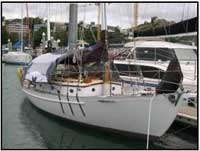[expand all]
Purpose
This information provides the Department of Agriculture and Water Resources (the department) requirements for itinerant vessels with timber components and vessels being imported into Australia. This information is provided to ensure that the risk of introducing an exotic pest or disease, via vessels and other seacraft, is managed effectively.
Who is affected by this information?
This information applies to:
Owners of sailed in itinerant vessels with timber components entering Australian waters, and owners of vessels, and brokers representing owners of vessels, that are imported into Australia as:
- containerised cargo
- break bulk cargo
- cargo on a specialist carrier
or entering Australian waters:
- by sailing, motoring or towing
- as returned Australian vessels
- as itinerant vessels
This information also applies to itinerant yacht owners and other vessel owners who are issued with an Department of Immigration and Border Protection 12 month cruising licence.
Why is the department interested in the timber components of vessels?
Vessels often contain built-in wooden structures like frames, decks, furniture, trims, bulkheads etc. Built-in wooden components or refitted wood and wood products in imported vessels can be of great biosecurity risk to Australia, particularly if the vessels have been refurbished in countries that pose a higher than normal risk for the presence of exotic timber pests (high risk countries).
Itinerant and returning Australian vessels also pose similar risks following their cumulative stay in high risk countries due to termites swarming (alate flight event) and potentially landing on and establishing and spreading in a vessel – a risk pathway for termite infestation. The department has implemented inspection and detection methods nationally to mitigate the risk of termite infestations and the introduction of other timber pests and diseases.
Timber pest detection (especially termites) in any structure or object is crucial to a termite control strategy. Wooden parts or portions of the vessels can be deeply coated or painted and can mislead the visual biosecurity inspection. Therefore complementary inspection methods such as termite detector dogs and other departmental approved termite detection methods used by a registered pest controller may be used to determine the risk status of the vessel.
What is the risk?
Termites are of great concern to the department. They can infest vessels if the vessel has visited countries where exotic species of these termites occur, there is an appropriate food source (timber) and optimum conditions available for pest entry establishment and spread via damage or other openings in the vessel structure or fittings. Exotic timber pests can also infest vessels if brought aboard in infested timber during refits or refurbishments.
Other timber pests of concern include:
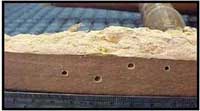
- auger beetles including the lesser auger beetle
- black carpenter ant
- European house borer
- drywood longicorn beetle
- African powderpost beetle
Further information about timber pests can be obtained from Forests and Timber: A Field Guide to Exotic Pests and Diseases.
Timber as a food source for termites and other timber pests is defined as both hardwood and softwood timber components that have been derived directly from sawn planks and includes:
- solid timber
- marine ply
- veneers over (a) and (b) above or if greater than 4mm thick.
Reconstituted wood products are defined as those products that, as a result of the manufacturing process, no longer contain solid wood (and hence are unattractive to burrowing timber pests). These products are not considered timber and include:
- particle board
- chip board
- masonite
- oriented strand board
- Medium Density Fibreboard (MDF)
- High Density Fibreboard (HDF).
| Plant and animal material, seeds and soil may accumulate in cupboards, lockers, collection points on decks, or even in the anchor well over time. These areas should be inspected and cleaned out regularly. |
 |
| Hitch-hiking pests may not be present as an infestation, but often use vessels as a means of transport from one place to another. |
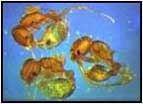 |
| Stored product pests are those moths, weevils, beetles and other larvae that may infest foodstuffs or food residues. |
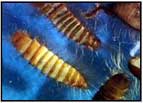 |
| Mosquito larvae and eggs may be present in fresh water reservoirs or other water collection points aboard vessels. |
 |
| Didymosphenia geminata (Didymo) may be present as an infestation of algae if the vessel has been in contact with fresh water in countries where Didymo is present. |
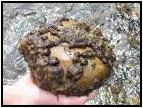 |
| External hull pests may be present underneath the vessel, either attached to the hull itself or secreted away in pipes, propellers and other crevices. These pests include mussels (including the exotic zebra mussel), crabs, starfish, barnacles and aquatic plants. |
 |
Determining the timber pest risk of a vessel
Departmental officers will perform several risk assessment activities to determine the risk of your vessel.
Documentation assessment
This information applies to all vessels regardless of mode of arrival (cargo or sailed in). Each consignment must be accompanied by sufficient documentation to allow the department to determine the vessels age, country of manufacture, construction type and materials used (including refit), former location/s, and travel and treatment history.
Examples of appropriate documentation may include:
- vessel log book
- vessel travel history
- treatment certificates
- manufacturers declaration
- commercial invoices
- maintenance records
- overseas government documents
- surveyor reports
- bills of lading
- packing declarations
- photographs.
For vessels imported as cargo, any packaging material used with the consignment must be clean and new, and any containers, timber packing, pallets or dunnage will be subject to inspection and treatment on arrival, unless certified as having been treated by the department approved method (refer to Cargo containers: biosecurity aspects and procedures).
Initial biosecurity inspection (sailed in vessels only)
Vessels sailed in to Australia, including international and returning Australian vessels, are subject to biosecurity inspection on arrival. All of these vessels are required to meet the same requirements regardless of origin. A timber pest inspection will be conducted by accredited seaports officers at the time of the initial pratique inspection.
Depending on the results of the documentation assessment and/or the initial biosecurity inspection, vessels arriving in Australia will be assessed as either low risk or high risk for timber pests.
Vessels arriving without the required documentation and/or vessel history will automatically be regarded as high risk vessels.Vessel preparation
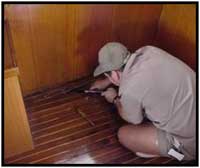
In order to make the inspection process more efficient, it is important that the vessel is prepared in such a way that makes it accessible for effective inspection. For example:
- the vessel should be secured in such a way that prevents excessive movement during the inspection
- remove all hazardous items
- access needs to be provided to all timber surfaces
- remove all panels, stored food, personal effects and other equipment from lockers/cupboards
Timber inspection
Depending on the results of the documentation assessment and/or the inspection, vessels will be assessed as either low risk or high risk for timber pests.
Those vessels assessed as representing a low risk will be released if no other biosecurity intervention is necessary.
High risk vessels (sailed in or imported as cargo)
For vessels assessed as high risk at either the pratique inspection or the inspection for importation, any evidence of insect infestation, or the detection of live insects themselves, will require immediate department intervention which may include (at the owner’s expense):
- visual timber inspection/confirmation by a department accredited timber vessel inspector or department entomologist
- timber vessel inspection by an accredited supplier of termite detector dog services, with or without a departmental officer in attendance
- timber vessel inspection by an accredited supplier of alternative termite detection services with a department accredited timber vessel inspector or department entomologist in attendance
- treatment using a department approved method.
Important notes for vessel owners
- Owners should be aware that more than one inspection may be required to resolve the biosecurity risk, depending on the complexity of the vessel.
- The the department timber inspector may need to authorise the use of alternative termite detection devices or dogs if visibility and/or access is reduced or restricted, or there is a potential biosecurity risk detected or suspected within the structure of the vessel on initial inspection.
- The department timber inspections and alternative technologies for detecting timber pests are not available at all ports therefore you should contact the department to discuss availability options.
- The department will only undertaker timber inspections in safe conditions, during daylight hours and usually within normal office hours.
- Owners are responsible for the cost of all inspections and any treatments required by the department to resolve the biosecurity status of the vessel, this includes the travel costs if a department timber inspector/entomologist, alternative inspection provider or treatment provider is required to travel to the inspection location.
Where do I find further information?
For further information about the department's requirements for the timber components on vessels, please contact your local department office or the Cargo and Mail Section:
Email: Cargo and Mail Section
For further information, visit Importing vessels with timber components frequently asked questions. The Biosecurity Import Conditions system (BICON) provides information on import requirements for individual commodities.
Fees and Charges provides information on the fees and charges applicable for all programs.
For general Customs enquiries, contact the Australian Customs and Border Protection Service.

